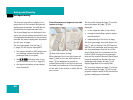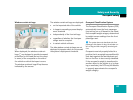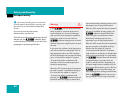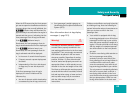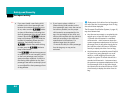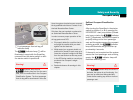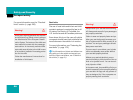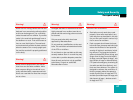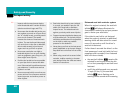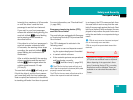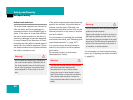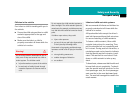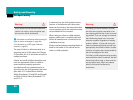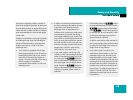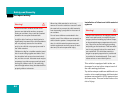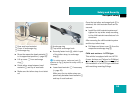
48
Safety and Security
Occupant safety
Enhanced seat belt reminder system
When the engine is started, the seat belt
telltale < will always illuminate for
6 seconds to remind you and your passen-
gers to fasten your seat belts.
If the driver’s seat belt is not fastened
when the engine is started, an additional
warning chime will also sound for a maxi-
mum of 6 seconds or until the driver’ s
seat belt is fastened.
If after these 6 seconds the driver’s or the
front passenger’s seat belt (with the front
passenger seat occupied) is not fastened
with front doors closed,
ț the seat belt telltale < remains illu-
minated for as long as either the driv-
er’s or front passenger’s seat belt is not
fastened.
ț and if the vehicle speed once exceeds
15 mph (25 km/h), the seat belt
telltale < starts flashing and a
warning chime sounds with increasing
impacts which exceed preset deploy-
ment thresholds and in certain rollovers
(window curtain air bags and ETD).
ț Never wear the shoulder belt under your
arm, against your neck or off your shoul-
der. In a frontal crash, your body would
move too far forward. That would
increase the chance of head and neck
injuries. The seat belt would also apply
too much force to the ribs or abdomen,
which could severely injure internal
organs such as your liver or spleen.
ț Never wear seat belts over rigid or
breakable objects in or on your clothing,
such as eyeglasses, pens, keys, etc., as
these might cause injuries.
ț Position the lap belt as low as possible
on your hips and not across the abdo-
men. If the seat belt is positioned across
your abdomen, it could cause serious
injuries in a crash.
ț Never use a seat belt for more than one
person at time. Do not fasten a seat belt
around a person and another person or
other objects.
ț Seat belts should not be worn twisted.
In a crash, you wouldn’t have the full
width of the seat belt to distribute
impact forces. The twisted seat belt
against your body could cause injuries.
ț Pregnant women should also always use
a lap-shoulder belt. The lap belt portion
should be positioned as low as possible
on the hips to avoid any possible
pressure on the abdomen.
ț Never place your feet on the instrument
panel, dashboard or on the seat. Always
keep both feet on the floor in front of the
seat.
ț When using a seat belt to secure infant
restraint, toddler restraint, or booster
seat, always follow the child seat manu-
facturer’s instructions.
୴୴



